This review took over a year to come to fruition. I had been in contact with Musical Surroundings, the distributor of the Aesthetix product line, for several years. Garth Leerer, the head of Musical Surroundings and a nice guy, offered for me to pick up the Calypso Signature preamplifier at the close of last October’s Rocky Mountain Audio Fest. As we were packing the preamplifier, I asked about the immediate future plans for the Atlas power amplifier and Garth kindly offered to let me audition it along with the preamplifier. I was thrilled at his generosity and support.
At the same audio show, one of the best systems was at Denver dealer Audio Unlimited’s large room which featured the Calypso Signature and pair of mono Atlas’ driving large Hansen loudspeakers. The sound of this system had a pervasive sense of ease and naturalness that made listening a real pleasure. This system identified this room as a refuge from the vagaries of the show and provided a way to “retune” my ears before venturing into more listening rooms.
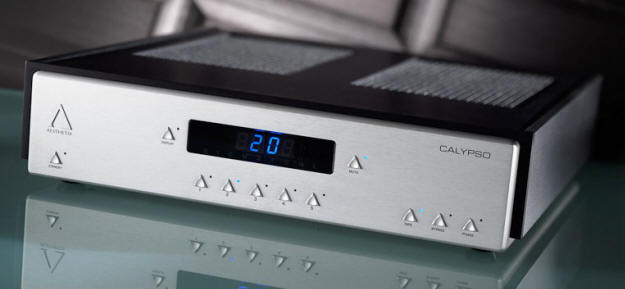
Jim White is the owner and creative force behind Aesthetix which gained attention years ago with its groundbreaking Io phono preamplifiers. The Io’s price of $15,000 puts it out of reach of most audiophiles. Several years ago, Mr. White began marketing the Saturn product line which includes the Calypso line stage preamplifier, Rhea phono preamplifier, and the Janus, which is a line stage + phono preamplifier. These products offer state of the art features, including numeric displays, remote control, and full adjustability to allow them to perform well in a variety of systems. More recently, the Atlas power amplifier was added to the line. Formerly a boutique brand, Aesthetix is rapidly emerging as a major player in high-end audio due to Mr. White’s keen listening skills and great talent as an electrical engineer.
The $7,000 Calypso Signature line stage is an upgrade to the well-received standard $5,000 Calypso model. The Signature version includes many upgraded parts and, as in the standard version, offers balanced XLR and unbalanced RCA inputs and outputs, remote control, dimmable displays, and other features that make it a pleasure to use. The remote control can switch phase, adjust gain, change inputs, and mute the output. A very welcome feature is a rapid ramp-up of volume when the preamp is un-muted, which avoids potentially damaging spikes from assaulting the speakers.
The $8,000 Atlas stereo power amplifier offers over 200 Watts per channel and weighs a reasonable 70 pounds. Interestingly, the Atlas is the only power amplifier, in both stereo and mono versions, made by Aesthetix. Mr. White seems to feel that its performance is sufficiently adept to offer a good pairing with his more upscale Jupiter line of products, which includes the Io Eclipse phono and Callisto Eclipse line preamplifiers. My guess is that there is a Jupiter series power amplifier in the works.
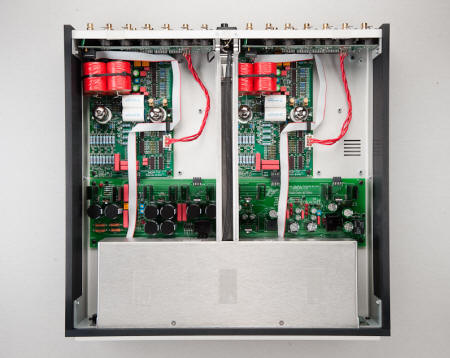
Other components on hand during the audition included a SOTA Cosmos vacuum turntable with Triplanar VII u2 tonearm, Miyajima Shilabe and Premium Mono phono cartridges, Mark Levinson No. 326S preamplifier with built-in phono stage, Prism Orpheus Digital Interface with custom Windows 7 computer/music server, YG Acoustics Kipod Main Modules speakers, Dali Mentor 5 loudspeakers (from the home theater system), Gallo Reference Stradas, and pairs of Gallo TR-3 and Velodyne Optimum-12 subwoofers. Power amplifiers included Bryston 4B SST2 and 7B SST2s. All interconnects and speaker cables are Mogami, which is recommended by Aesthetix as some of the internal wiring is Mogami. All front end components, including the preamplifiers, receive their AC power from a PS Audio AV-5000 power conditioner which is connected to the wall power with a 1 meter length of PS Audio AC-12 power cord. An Audience aR2p-TO power conditioner is usually employed for the power amplifiers.
The Calypso Signature preamplifier is very quiet. There is no tube hiss or other indication that there are two 12AX7 and two 6922 vacuum tubes at play until the volume control indicates a level of 75. The maximum setting is 88. Since I usually listened in the 50-60 range, noise was never an issue. I generally find the 12AX7/12AT7 tubes to be very musical. The 6922 certainly can be a good sounding tube, but its acceptability seems to be closely tied to the manufacturer, and even the production date and lot number. For example, NOS Mullard 6922/6DJ8s usually sound excellent, while later Sovteks do not. However, I did not experiment with different tubes in either the Calypso or the Atlas. What I got is what I reviewed.
The Calypso is silent as a tomb/bottom of the ocean/Oval Office/outer space. This extreme lack of noise and distortion offers natural detail and harmonics to be heard to the limits of the recording. This helps with the sound of strings, for one example. Listen to “Losin’ End”, from Doobie Brothers Takin’ It To The Streets LP and you will hear string tone with beautiful consistency and depth. The display of micro-dynamic energy is highlighted in the sounds of the tambourine, the drum sticks hitting their targets, and the guitar picks flicking the strings. You can hear the same qualities in both “Neal’s Fandango” and “Slat-key Soquel Rag” on the Doobie’s Stampede LP, too.
A lot of this micro-dynamic quality results from the preamp’s ability to accurately deliver the beginning of each note. Because the start of every sound is correct, the rest of the note makes sense. It is like looking at a person through waxed paper: without the edge detail, it is difficult to identify who is standing in front of you. Remove the wax paper and the image becomes real.
There is a wonderful feeling of rhythm and flow, with each note naturally leading to the next note. There is not the laboratory dissection of each note, an individual sound existing as a separate entity that is the bane of many solid state devices. Listen to Jim Morrison’s voice on “Peace Frog” on the Door’s Morrison Hotel LP. This very exciting rhythm melts into the melodic “Blue Sunday”. Morrison could easily have matured into his generation’s Sinatra if his flame had continued. Morrison Hotel is included in the recent 7-LP reissue set, a very well-done collection and a great ride into 70’s rock. What a trip!
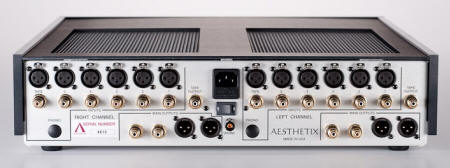
As good as the Calypso Signature is with instruments, providing outstanding orchestral performances, its special talent is with the human voice. The Aesthetix preamp has such high resolution that every voice is imbued with the tonal richness and depth that only very fine components – and live music – can deliver. Vocals are presented in such a complete and intimate way that the listener’s attention is drawn to the artistic performance and away from the fact of an electronic sound system. While some components are good with simple ensembles or solo artists, the Calypso’s full beauty is demonstrated with complex music and choirs large and small. The ability of the preamp to deliver each part of the performance, clearly and without congestion, is easily at reference level.
I confess: I’m a detail freak. I want to be able to hear a gnat sneeze. If a system does not wholly present every sound, every nuance, every inflection, part of the performance is lost. Fortunately, the Calypso Signature does an excellent job of letting through all of the music. Comparing the Calypso’s very rich tonal purity to high definition video, the preamp delivers all 16.7 million colors, each one clearly defined. You get burgundy, or garnet, or ruby, or blood, or fire engine, or crimson, or cherry, or scarlet, etc., not some unknowable reddish ambiguity. My only reservation is in the highest treble range where the Calypso Signature was less resolved and informative than either a bypass connection, using the Prism Orpheus Digital Interface connected directly to the power amplifier, or the reference preamp. This removes a touch of sparkle and air that is present in many recordings.
The user interface and remote control are welcome features and make the preamp a pleasure to use on a daily basis. Sometimes the volume steps were a little too large to obtain the exact volume I wanted. The construction quality and finish of the preamplifier is absolutely first-class and it worked perfectly with no operational problems or glitches. The plastic-body remote control may seem more suited for budget gear, but its light weight offered a benefit for a hand-held device.
The Atlas power amplifier will make many music lovers very happy. After about a 15 minute warm up, the Atlas is consistently musical. Its relatively compact size and 70 pound weight make for a manageable package. The short feet requires placing the amplifier on a solid, flat surface for proper cooling. The lower side edges can get very warm so make sure you let the amplifier cool down (or wear gloves) before lifting from the sides.
The Atlas has a couple of unique features. It uses a single vacuum tube for each channel on the input, and the output stage is full-on modern solid state. The 6SN7 tube is one of the most neutral tubes available and has a very long life expectancy. The second feature is a built in crossover, which you can switch in or out of the circuit, that will limit the bass signal going to the main speakers. This can be a worthwhile feature if you use smaller main speakers and a subwoofer or two. The crossover, with adjustable frequency, will remove much of the lower bass and may reduce intermodulation distortion from the main speaker, especially a 2-way in which a small woofer is required to pump out a lot of bass at high volumes and also deliver a finely detailed upper midrange at the same time. If the big bass notes overpower the midrange you have IM distortion. The Atlas’ crossover is very high quality and sounds a bit better than the built-in crossovers of either the Velodyne Optimum-12 or Gallo TR-3 subwoofers.
The built-in crossover has an effect on the sound of the main speakers, even though the effect is less than using the built-in crossovers from either of the subwoofers mentioned above. The sound stage is very slightly smaller, although the specificity of individual instruments improved just a bit. Instruments that present of lot of content in the lower to mid treble, such as bells and triangles, sound more prominent than with the Atlas’ built-in crossover switched out of the game. One of the main reasons for using the built-in crossover is to reduce the bass content from the main speakers and thereby reduce IM distortion. I did not listen loud enough to reliably ascertain if there was any reduction in distortion as the YG Acoustics Kipods do not suffer this problem at any normal volume level in my room. With modern low distortion speakers, if IM distortion – from playing your music too loudly – is a problem, you probably need larger speakers with greater loudness (SPL) capabilities. In my medium-small room, I run the 2-way Kipod Main Modules “full range” without any external crossover scheme.
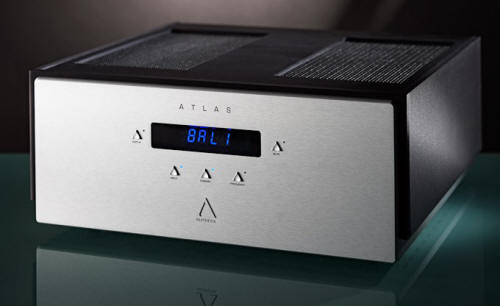
There may not be a perfect power amplifier, but the Atlas comes close to that ideal. Tonally, the sound is gorgeous. Brass instruments have just the perfect balance of bite and metallic sheen. Too much of the former and you get the musical equivalent of static: no body. Too much of the latter provides tone without the character of the instrument: no life. Both are needed for music to live.
The Atlas delivers a very convincing virtual sound stage. The depth is among the best I have ever heard in my room. Instruments are fully resolved and they have a very natural sense of individual depth and body. The stage is realistically layered front-to-back. Left-to-right image placement is outstanding, too. Offering a huge, very three-dimensional sound stage, the Atlas will not disappoint in this area.
Reproduction of the human voice is the special strength of the Atlas. The very high resolution across all the audible octaves, without any highlights to grab your immediate attention – and eventually become annoying – breathes body and texture into every vocal. From Bonnie Raitt to Sade to Emmylou Harris to Rickie Lee Jones, women’s voices sound wonderful. This doesn’t make Jones any more understandable, though, as she often slurs and mumbles her way through some very creative tunes. Listening to Tina Turner exhale her sex-drenched “aaahhhhhh…” a few seconds into “Private Dancer” will take your breath away.
I have some small quibbles with the Atlas, which you might think rise to the level of problems simply because of the amount of space devoted to them below. Please don’t make that mistake, as these comments really describe character and not defects in the very musical performances which the Atlas easily delivers.
The amplifier is very sensitive to power. Changing the power cord and especially plugging the power cord directly into the wall and not through a power conditioner or distribution center can have a significant impact on the dynamic impact and feeling of musical excitement. Even so, there is a small reticence in bass dynamics which are nicely offset by incredible detail and texture in the lower frequencies. The Atlas is masterful with bass drums, too. If your speakers are up to the challenge, the Atlas will let you hear the head of the drum vibrating better than any other amplifier I can recall. If you like to hear individual strings vibrating on acoustic basses of all kinds, the Atlas will make you very happy. Yes, it will!
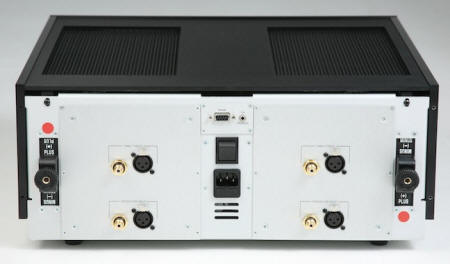
Compared to the Bryston 7BSST2 amplifiers, the Atlas has a slightly different sonic balance. The Atlas is a bit warmer sounding, like taking just a bit of mid-treble, around 5k Hz, and moving that energy to the middle C (262 Hz) area. The difference is subtle, but noticeable. The Atlas has a fuller sound with that characteristic big sound we get from tubes. Even with the low tube-sound 6SN7, the presence of tubes is apparent although never overpowering or artificial.
The main difference between the Aesthetix and Bryston amplifiers is in large scale dynamic impact. The Bryston 7BSST2 has noticeably more punch-in-the-gut slam and impact than the Atlas. This can be mitigated somewhat by deliberate selection of power cords and using a direct power connection to the wall, but it is a character that remains. The Audience PowerChord e worked very well. I think perfection in a power amplifier could be the combination of the dynamic prowess and slightly more linear sound of the Brystons with the richly harmonic and human heart of the Atlas. Since I need to hear the power of a kettle drum or the hammer strike the piano wires with all the power included on the recording, I find the Bryston’s charms to be irresistible. Another listener might very well prefer the slightly different but still outstanding musicality of the Atlas.
If your goal is some perfectionist ideal of maximizing every analytical micro-specific trait we audiophiles sometimes fuss over, then you might not find long-term bliss with the Atlas. On the other hand, if you value tone over fireworks, being swept away instead of challenged, the beautiful sounding Aesthetix Atlas could be a completely satisfying musical partner.
When I stopped dissecting the individual performances of the Atlas power amplifier and Calypso Signature preamplifier and connected the two together, the overall sound transcended “reference quality” and entered the realm of “music quality”. The combination of the two Aesthetix components attained a level of tonal completeness and harmonic integrity that was very enjoyable and entertaining. The defining character of the combination of preamp and amplifier is texture. Ever present is a rich, dense tapestry of music that is the opposite of thin, flat, bland, or dry. While not perfectly neutral in certain areas, either or both components can and do offer musicality at a level that belies their asking prices.
Overall Ratings:
Calypso Signature Preamplifier: 9.5 LPs
Atlas Stereo Power Amplifier: 9 LPs
Link to Musical Surroundings
Link to Aesthetix
